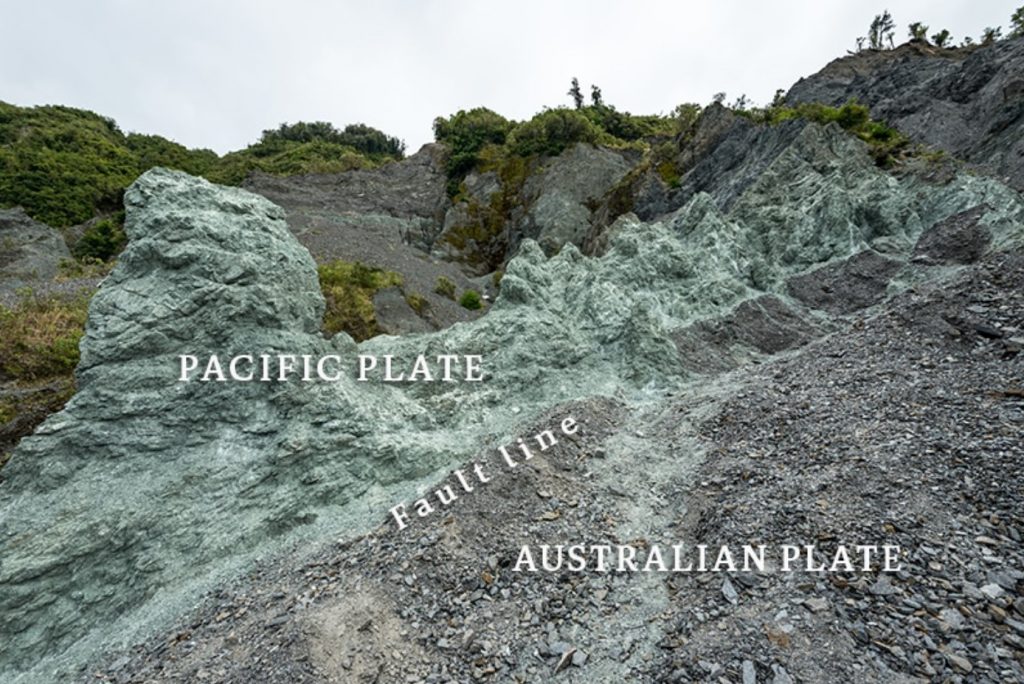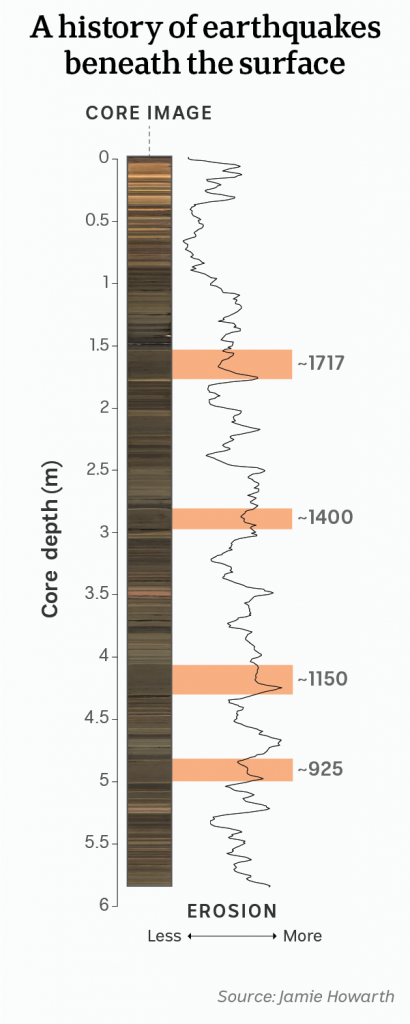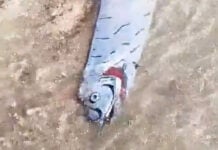Pressure is building along the Alpine Fault, one of the most active fault lines in the world and New Zealand is in a race to be ready. Latest results show that a great earthquake, one of the biggest in New Zealand’s modern history, is due.

Description of the Alpine Fault
For millions of years, the shifting Australian and Pacific tectonic plates below have been pushing together, buckling, breaking the ground and moulding this mountain range.
Where the two plates meet on land is known as the Alpine Fault, a 850-kilometer seam in the Earth’s crust that traces an almost perfect path along the western foothills of the alps.

On average, the plates move 2-3 centimeters a year relative to each other. It may sound slow, but in geological time that’s a blistering pace. But instead of being gradual movement, the plates move several meters at a time every few hundred years.
Scientists believe these plates are due to move again and when it happens it will trigger a powerful earthquake.
Timeline of earthquakes along the Alpine Fault
In studying the Alpine Fault, scientists have created a timeline of its history and they know it makes very big shifts, on average, about every 300 years.
It’s complex science that dates the last magnitude-8 earthquake along the fault line to the year 1717.
Simple maths tells us it’s been more than 300 years since then.
So, what kind of earthquake is next for the Alpine Fault?
That’s the question senior lecturer in physical geography at the Victoria University of Wellington Jamie Howarth and his team recently set out to answer.
The team developed the richest record yet of the Alpine Fault’s history and found a pattern, one that helps them reliably forecast what’s to come.
The research team drilled down six meters and extracted a cross-section of the lake bed, revealing a literal line-by-line snapshot of its history.
“[It] gets us back a few thousand years into the past and then we can read that record like a book, identify those past earthquakes and date them,” Jamie said.
In this sample, the red zones represent each major Alpine Fault earthquake back to the year 925AD.

The strong shaking in these events deformed the layers of sediment, causing them to collapse and blend together.
The shaking also destabilised material at the edge of the lake and caused underwater landslides, again deforming the perfect layers — or lines — of sediment that would otherwise be there.
75% chance of a Big One along the Alpine Fault in the next 50 years
Until this research, the probability of a large earthquake along the Alpine Fault within the next 50 years was understood to be about 30 per cent.
That number has now changed.
There is now a 75 per cent chance a large earthquake will happen along the Alpine Fault in the next 50 years, according to the research.
“But we can take it a step beyond that,” Jamie said.
“We see that it has an 82 per cent chance that it’s going to be another one of these multi-section, very long ruptures that have a magnitude in excess of eight.”
What will the Alpine Fault earthquake be like?
Researchers at the University of Canterbury used a supercomputer to generate simulations of a large Alpine Fault earthquake and it gives some sense of how widespread the impact could be.
They modelled how much the ground would shake in one possible scenario. In their simulation of a magnitude-7.9 quake, the rupture starts in the south.
The ground moves the most along the west coast. The spikes moving across the South Island show how much the ground is moving in that spot, at that time.
It depends on a range of other conditions, but shaking of this intensity can tear the ground apart. The ground could slip up to 10 meters horizontally and 2 meters vertically. About 90 seconds after the first rupture, New Zealand’s east coast would be shaking too.
Depending on the type of building, it’s likely items would be falling from shelves. Local councils on this side of the South Island forecast being cut off by large landslides. In a little more than 3 minutes, the whole of New Zealand’s South Island would have felt the ground move.
New Zealand response to an Alpine Fault earthquake
How New Zealand responds in the week following a large Alpine Fault earthquake is mapped out in a scenario developed by Caroline, the AF8 group, multiple agencies and governments.
The scenario plans for damage to electricity and telecommunications networks, disruption to the supply of fuel and food, landslides, rockfalls, tens of thousands of people being displaced, thousands of people with at least minor injuries and hundreds of deaths.
The “immediate mission” will be “search and rescue operations and delivery of services for trapped, injured and dependent individuals and groups” across the South Island.
“There will be hundreds of thousands of landslides and rockfalls in steeper terrain near the Alpine Fault and throughout the South Island,” the scenario document reads.
Tsunamis along the coast are unlikely, but the lakes and fjords along the Alpine Fault will be vulnerable to inundation and the AF8 scenario forecasts they will cause “significant damage or loss of life”.
The Alpine Fault is one of the most well-understood fault lines in the world.
The geological archives stored in and around New Zealand’s Southern Alps date back millennia.
Reading those archives leads to the very clear conclusion that a magnitude-8 earthquake is part of the Alpine Fault’s next chapter and, when you consider the age of these hills, it won’t be long.
The earthquake is inevitable and the science is telling us, in an even more pointed way, it’s going to happen probably sooner than we think… 50 years is nothing in geological time, nothing at all.
So if I were living along this fault line, I would prepare for the next big one step by step, without rush, but keeping in mind it could happen any time now! [Nature, ABC.net.au]
Now subscribe to this blog to get more amazing news curated just for you right in your inbox on a daily basis (here an example of our new newsletter).
You can also follow us on Facebook and/ or Twitter. And, by the way you can also make a donation through Paypal. Thank you!
You should really subscribe to QFiles. You will get very interesting information about strange events around the world.













Beautiful area. Thinking about all the wildlife that will suffer.
Most of the people are pretty liberal out there. Then you have the satanic elitists and actorpedos that buy up land and build their bunker hideouts, with all their gold and jewels.
There’ll be a huge problem with that, .50cal; the Alpine Fault’s already overdue for a huge earthquake, so building a bunker wouldn’t be of help at all for those satanic elitists and acctorpedos. They’d all die – either by the falling rocks or the rising waters – and their treasures would all be scattered. Their best bet would be to leave the area and build their bunker(s) in Australia.
Eileen,
Yeah Australia would be better. Even their government has gone full tilt lefty.
Problem is there isn’t really any place that’s safe from tyrants or cataclysmic events now.
40 years ago you know, my mother bought a place in Austraila. She liked it. She said it felt like the 1950’s. She sold it for a profit. I never got a chance to even go there.
Probably would have liked it. I like wild animals, and beaches. Sharks not so much.
Simple MATHS tell us. MATHS??
Mathematics would have been better, but today we have plenty of typos, and lack of proofreading.
Much more than previous decades. See it everywhere online now.